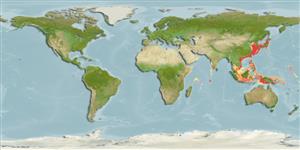Common names from other countries
Lớp phụ Cá sụn (cá mập và cá đuối) (sharks and rays) >
Carcharhiniformes (Ground sharks) >
Triakidae (Houndsharks) > Triakinae
Etymology: Mustelus: Latin for weasel, an ancient name for sharks, possibly referring to the pointed snouts, swift movements and/or rapacious feeding behavior of smaller predatory sharks [strictly not tautonymous with Squalus mustelus Linnaeus 1758 since type was designated by the ICZN]. (See ETYFish); manazo: Japanese vernacular for this shark. (See ETYFish).
More on author: Bleeker.
Environment: milieu / climate zone / depth range / distribution range
Sinh thái học
Biển gần đáy; Mức độ sâu 0 - 360 m (Ref. 13563). Tropical; 45°N - 10°S
Western Indian Ocean: Kenya. Western Pacific: southern Siberia, Japan, Korea, China, Taiwan and Viet Nam; Chesterfield Islands (Ref. 11897).
Length at first maturity / Bộ gần gũi / Khối lượng (Trọng lượng) / Age
Maturity: Lm 65.0, range 62 - 68 cm
Max length : 220 cm TL con đực/không giới tính; (Ref. 4883); Khối lượng cực đại được công bố: 5.7 kg (Ref. 40637); Tuổi cực đại được báo cáo: 10 các năm (Ref. 6081)
Found in the intertidal zone, on mud and sand bottom, down to a depth of at least 360 m (Ref. 13563). May also be found in semi-enclosed sea areas (Ref. 11230). Feeds mainly on bottom invertebrates, also bony fishes (Ref. 244). Ovoviviparous (Ref. 50449). Caught regularly by demersal longliners operating both inshore and in deep-water (Ref.58048). Utilized for human consumption (Ref. 244).
Ovoviviparous, embryos feed solely on yolk (Ref. 50449), with 1 to 22 (Ref.58048 reports 5-14)young in a litter. Gestation period takes about 10 months (Ref. 244) or 11-12 months (Ref. 28055). Young born in spring. Distinct pairing with embrace (Ref. 205).
Compagno, L.J.V., 1984. FAO Species Catalogue. Vol. 4. Sharks of the world. An annotated and illustrated catalogue of shark species known to date. Part 2 - Carcharhiniformes. FAO Fish. Synop. 125(4/2):251-655. Rome: FAO. (Ref. 244)
IUCN Red List Status (Ref. 130435)
CITES (Ref. 128078)
Not Evaluated
Threat to humans
Harmless
Human uses
Các nghề cá: Tính thương mại; cá để chơi: đúng
Các công cụ
Special reports
Download XML
Các nguồn internet
Estimates based on models
Preferred temperature (Ref.
115969): 14.4 - 28.1, mean 23.2 (based on 677 cells).
Phylogenetic diversity index (Ref.
82804): PD
50 = 0.5000 [Uniqueness, from 0.5 = low to 2.0 = high].
Bayesian length-weight: a=0.00214 (0.00117 - 0.00391), b=3.13 (2.97 - 3.29), in cm Total Length, based on LWR estimates for this species & Genus-body shape (Ref.
93245).
Mức dinh dưỡng (Ref.
69278): 3.7 ±0.1 se; based on diet studies.
Thích nghi nhanh (Ref.
120179): Rất thấp, thời gian nhân đôi của chủng quần tối thiểu là hơn 14 năm (K=0.07; tm=1.9-4; tmax=10; Fec=1).
Fishing Vulnerability (Ref.
59153): High vulnerability (63 of 100).
